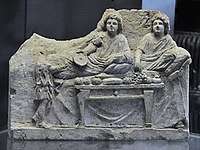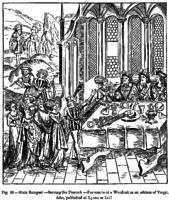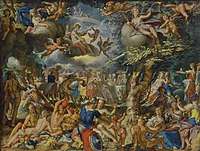Banquet
A banquet (/ˈbæŋkwɪt/; French: [bɑ̃kɛ]) is a formal large meal or feast,[1] often involving main courses and desserts. The meal tends to serve a purpose such as a charitable gathering, a ceremony, or a celebration, frequently involved either preceding or following speeches in honor of the topic or guest of honour. [2]
| Part of a series on |
| Meals |
|---|
 |
| Meals |
| Components and courses |
| Related concepts |
Historical context
Despite the controversy surrounding the origins of feasting, numerous theories have been suggested. According to archaeologist Brian Hayden, feasts were an important social event either facilitated by or featuring the surplus of food, resulting in the experience gaining social and political ties and a competitive element to display one's own wealth. Whilst Bendall suggests the importance of luxury foods,[3] Hayden argues the likelihood that animal meat and rice were part of these luxury goods.[4]
Banqueting, as a notion, has manifested itself in a variety of forms throughout history. In Ancient Greece, symposia, an early kind of banquet, formed a routine part of life involving the celebratory drinking of wine, conversation and performances of poetry and music.[5]
Banquets persisted in popularity over the years including Belshazzar's Feast, Last Supper, Manchu Han Imperial Feast, and Mead halls.
By the Middle Ages, the event had become more structured, with comprehensive ritualised elements were involved in the traditional three-course menu, which could have up to 25 dishes in each course (this structure persisted into the 19th century). The structure was later altered to two courses, with the pre-existing third course changed to the serving of fruit and nuts.[6]
Banqueting rooms varied greatly with location, but tended to be on an intimate scale, either in a garden room, banquet hall or inside such as the small banqueting turrets in Longleat House.
Contemporary times
- A contemporary banquet may serve many purposes from training sessions, to formal business dinners. Business banquets are a popular way to strengthen bonds between businessmen and their partners. It is common that a banquet is organized at the end of an academic conference. A luau is one variety of banquet originally used in Hawaii. The Nei Mongol provincial government in China levies a tax on banquets.
 Hellenistic banquet scene
Hellenistic banquet scene A banquet for Babur
A banquet for Babur- A Chinese painting of an outdoor banquet, from the era of the Song dynasty (960–1279).
 State Banquet. Serving the Peacock. Facsimile of a woodcut in an edition of Virgil, folio, published at Lyons in 1517.
State Banquet. Serving the Peacock. Facsimile of a woodcut in an edition of Virgil, folio, published at Lyons in 1517. Joachim Wtewael: Banquet of the Gods, around 1602
Joachim Wtewael: Banquet of the Gods, around 1602- Chinese banquet for a birthday celebration
See also
| Wikimedia Commons has media related to Banquets. |
| Look up banquet in Wiktionary, the free dictionary. |
References
- "Banquet." (definition). Merriam-webster.com. Accessed August 2011.
- "BANQUET | meaning in the Cambridge English Dictionary". dictionary.cambridge.org. Retrieved 2019-03-29.
- Bendall, L. 2004: Fit for a King? Hierarchy, exclusion, aspiration and desire in the social structure of Mycenaean banqueting. In Halstead, P. and Barrett, J.C. (eds), Food, Cuisine and Society in Prehistoric Greece (Oxford, Sheffield Studies in Aegean Archaeology 5), 105–35.
- Hayden, Brian (2003). "Were luxury foods the first domesticates? Ethnoarchaeological perspectives from Southeast Asia". World Archaeology. 34 (3): 458–469. doi:10.1080/0043824021000026459a.
- Department of Greek and Roman Art. “The Symposium in Ancient Greece.” In Heilbrunn Timeline of Art History. New York: The Metropolitan Museum of Art, 2000–. http://www.metmuseum.org/toah/hd/symp/hd_symp.htm (October 2002)
- Scanlon Loman, Nancy (2013). Catering management (4th ed.). Hoboken, N.J.: Wiley. ISBN 9781118091494. OCLC 774863928.
Further reading
- Albala, Ken (2007). The banquet: Dining in the Great Courts of late Renaissance Europe. Board of Trustees, University of Illinois. ISBN 978-0-252-03133-5.
